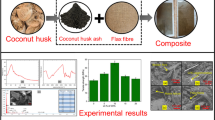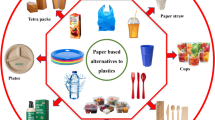Abstract
The textile industry has a strong interest in superhydrophobicity and water repellence and, in particular, in the development of waterproof, self-cleaning and stain-resistant clothing and other textile products. In this study, to promote hydrophobicity in textiles, novel fluorine-free formulations were developed based on long-chain cellulose esters (LCCEs), synthesized from recycled cellulose in a heterogeneous system. The synthesized LCCEs (with alkyl side chains containing 6 to 18 carbon atoms, C6-C18) were characterized by spectroscopic (nuclear magnetic resonance and Fourier-transform infrared spectroscopy) and thermal (thermogravimetry analysis and differential scanning calorimetry) methods in order to validate their synthesis and intrinsic characteristics. The recycled cellulose was obtained from textile residues, in a circular approach toward textile functionalization. The developed formulations contain regular dry-cleaning solvents. Because of their nontoxicity, and ease of application by conventional drycleaning methods, these LCCEs provide a simple, eco-friendly, sustainable and effective alternative to the compounds currently used for promoting water repellency in textiles. The fabrics treated with the LCCE-based formulations were evaluated for static and dynamic contact angles, surface energy, wettability, water vapor permeability and cytotoxicity. The resistance of the treatment to domestic washing and thermal treatment was also assessed.






Similar content being viewed by others
References
ASTM E96-16: (2016) Standard test methods for gravimetric determination of water vapor transmission rate of materials
Balser K, Hoppe L, Etcher T et al. (2004) Cellulose esters. In: Ullmann’s encyclopedia of industrial chemistry. Wiley-VCH Verlag. pp 333–380
Bhushan B, Her EK (2010) Fabrication of superhydrophobic surfaces with high and low adhesion inspired from rose petal. Langmuir 26:8207–8217. https://doi.org/10.1021/la904585j
Bras J, Vaca-Garcia C, Borredon ME, Glasser W (2007) Oxygen and water vapor permeability of fully substituted long chain cellulose esters (LCCE). Cellulose 14:367–374. https://doi.org/10.1007/s10570-007-9123-2
Costa C, Viana A, Silva C, Marques EF, Azoia NG (2022) Recycling of textile wastes by acid hydrolysis, into new cellulosic raw materials. Waste Manage 153:99-109. https://doi.org/10.1016/j.wasman.2022.08.019
Crépy L, Chaveriat L, Banoub J et al (2009) Synthesis of cellulose fatty esters as plastics-influence of the degree of substitution and the fatty chain length on mechanical properties. Chemsuschem 2:165–170. https://doi.org/10.1002/cssc.200800171
Crépy L, Monchau F, Chai F et al (2012) Evaluation of a bio-based hydrophobic cellulose laurate film as biomaterial-study on biodegradation and cytocompatibility. J Biomed Mater Res Part B Appl Biomater 100:1000–1008. https://doi.org/10.1002/jbm.b.32665
Desbois AP, Smith VJ (2010) Antibacterial free fatty acids: Activities, mechanisms of action and biotechnological potential. Appl Microbiol Biotechnol 85:1629–1642. https://doi.org/10.1007/S00253-009-2355-3/figures/3
Di Mundo R, Palumbo F (2014) Wettability: Significance and measurement. In: polymer surface characterization. De Gruyter, pp 207–246
Edgar KJ, Buchanan CM, Debenham JS et al (2001) Advances in cellulose ester performance and application. Prog Polym Sci 26:1605–1688. https://doi.org/10.1016/S0079-6700(01)00027-2
Fan Z, Li Q, Cai X et al (2017) Synthesis of core-shell fluorine-silicon containing polyacrylate latexes for water and oil repellent finishing of cotton fabric. Indian J Fibre Text Res 42:495–501
Feng L, Li S, Li Y (2002) Super-hydrophobic surfaces: from natural to artificial. Adv Mater 14:1857–1860. https://doi.org/10.1002/adma.200290020
Feng L, Zhang Y, Xi J et al (2008) Petal effect: a superhydrophobic state with high adhesive force. Langmuir 24:4114–4119. https://doi.org/10.1021/la703821h
Freire CSR, Silvestre AJD, Neto CP et al (2006) Controlled heterogeneous modification of cellulose fibers with fatty acids: effect of reaction conditions on the extent of esterification and fiber properties. J Appl Polym Sci 100:1093–1102. https://doi.org/10.1002/app.23454
Giesy JP, Kannan K (2001) Global distribution of perfluorooctane sulfonate in wildlife. Environ Sci Technol 35:1339–1342. https://doi.org/10.1021/es001834k
Havimo M, Jalomäki J, Granström M et al (2011) Mechanical strength and water resistance of paperboard coated with long chain cellulose esters. Packag Technol Sci 24:249–258. https://doi.org/10.1002/pts.932
ISO 10993: (2009b) Biological evaluation of medical devices — part 5: tests for in vitro cytotoxicity
ISO 23232: (2009a) Textiles—Aqueous liquid repellency—Water/alcohol solution resistance test
ISO 3175: (2017) Textile—professional care, drycleaning and wetcleanin of fabrics and garments—part 2: procedure for testing performance when cleaning and finishing using tetracholoethene
Jandura P, Riedl B, Kokta BV (2000) Thermal degradation behavior of cellulose fibers partially esterified with some long chain organic acids. Polym Degrad Stab 70:387–394. https://doi.org/10.1016/S0141-3910(00)00132-4
Jebrane M, Terziev N, Heinmaa I (2017) Biobased and sustainable alternative route to long-chain cellulose esters. Biomacromol 18:498–504. https://doi.org/10.1021/acs.biomac.6B01584
Klemm D, Heublein B, Fink HP, Bohn A (2005) Cellulose: fascinating biopolymer and sustainable raw material. Angew Chemie Int Ed 44:3358–3393. https://doi.org/10.1002/anie.200460587
Sealey JE, Samaranayake G, Todd JG, Glasser WG (1996) Novel cellulose derivatives. IV. Preparation and thermal analysis of waxy esters of cellulose. J Polym Sci Part B Polym Phys 34:1613–1620. https://doi.org/10.1002/(sici)1099-0488(19960715)34:9%3c1613::aid-polb10%3e3.0.co;2-a
Teflon teflon ecoelitetm renewably sourced finish (2022). https://www.teflon.com/en/industries-and-solutions/solutions/consumer-applications/textile-finishes/how-ecoelite-works
Uchida K, Nishikawa N, Izumi N et al (2010) Phototunable diarylethene microcrystalline surfaces: Lotus and petal effects upon wetting. Angew Chemie - Int Ed 49:5942–5944. https://doi.org/10.1002/anie.201000793
Uschanov P, Johansson L-S, Maunu SL, Laine J (2011) Heterogeneous modification of various celluloses with fatty acids. Cellulose 18:393–404. https://doi.org/10.1007/s10570-010-9478-7
Wang S, Jiang L (2007) Definition of superhydrophobic states. Adv Mater 19:3423–3424. https://doi.org/10.1002/adma.200700934
Wei DW, Wei H, Gauthier AC et al (2020) Superhydrophobic modification of cellulose and cotton textiles: Methodologies and applications. J Bioresour Bioprod 5:1–15. https://doi.org/10.1016/j.jobab.2020.03.001
Wen X, Wang H, Wei Y et al (2017) Preparation and characterization of cellulose laurate ester by catalyzed transesterification. Carbohydr Polym 168:247–254. https://doi.org/10.1016/j.carbpol.2017.03.074
Willberg-Keyriläinen P, Ropponen J (2019) Evaluation of esterification routes for long chain cellulose esters. Heliyon 5:e02898. https://doi.org/10.1016/j.heliyon.2019.e02898
Willberg-Keyriläinen P, Talja R, Asikainen S et al (2016) The effect of cellulose molar mass on the properties of palmitate esters. Carbohydr Polym 151:988–995. https://doi.org/10.1016/j.carbpol.2016.06.048
Willberg-Keyriläinen P, Vartiainen J, Harlin A, Ropponen J (2017) The effect of side-chain length of cellulose fatty acid esters on their thermal, barrier and mechanical properties. Cellulose 24:505–517. https://doi.org/10.1007/s10570-016-1165-x
Willberg-Keyriläinen P, Ropponen J, Alakomi H-L, Vartiainen J (2018) Cellulose fatty acid ester coated papers for stand-up pouch applications. J Appl Polym Sci 135:46936. https://doi.org/10.1002/app.46936
Wille JJ, Kydonieus A (2003) Palmitoleic acid isomer (C16:1Δ6) in human skin sebum is effective against gram-positive bacteria. Skin Pharmacol Physiol 16:176–187. https://doi.org/10.1159/000069757
Wu S (1971) Calculation of interfacial tension in polymer systems. J Polym Sci Part C Polym Symp 34:19–30. https://doi.org/10.1002/polc.5070340105
Wu S (1973) Polar and nonpolar interactions in adhesion. J Od Adhes 5:39–55. https://doi.org/10.1080/00218467308078437
Yang Q, Fujisawa S, Saito T, Isogai A (2012) Improvement of mechanical and oxygen barrier properties of cellulose films by controlling drying conditions of regenerated cellulose hydrogels. Cellulose 19:695–703. https://doi.org/10.1007/S10570-012-9683-7
Zhang Y, Chen Y, Shi L et al (2012) Recent progress of double-structural and functional materials with special wettability. J Mater Chem 22:799–815. https://doi.org/10.1039/c1jm14327a
Zhou Y, Min DY, Wang Z et al (2014) Cellulose esterification with octanoyl chloride and its application to films and aerogels. BioResources 9:3901–3908. https://doi.org/10.15376/biores.9.3.3901-3908
Funding
This work was supported by a PhD grant (ref. SFRH/BD/138665/2018) financed by national funds through Fundação para a Ciência e a Tecnologia and by the North Portugal Regional Operational Programme under Portugal 2020 through the European Social Fund (ESF). Financial support from CIQUP (UIDB/00081/2020) and IMS (LA/P/0056/2020) are also gratefully acknowledged.
Author information
Authors and Affiliations
Contributions
CC—Investigation, Formal analysis, Validation, Writing – original draft, writing—review & editing; CS—Supervision, writing—review & editing; E.F.M.—Supervision, Resources, Funding acquisition, writing—review & editing; NGA—Conceptualization, Supervision, Writing -original draft, Writing—review & editing.
Corresponding authors
Ethics declarations
Conflict of interest
The authors have no competing interests as defined by Springer, or other interests that might be perceived to influence the results and/or discussion reported in this paper.
Consent for publication
All of the material is owned by the authors and/or no permissions are required.
Additional information
Publisher's Note
Springer Nature remains neutral with regard to jurisdictional claims in published maps and institutional affiliations.
Supplementary Information
Below is the link to the electronic supplementary material.
Rights and permissions
Springer Nature or its licensor (e.g. a society or other partner) holds exclusive rights to this article under a publishing agreement with the author(s) or other rightsholder(s); author self-archiving of the accepted manuscript version of this article is solely governed by the terms of such publishing agreement and applicable law.
About this article
Cite this article
Costa, C., Silva, C., Marques, E.F. et al. Long-chain cellulose esters from recycling textile waste as highly effective superhydrophobic additive: synthesis and evaluation. Cellulose 30, 2913–2928 (2023). https://doi.org/10.1007/s10570-023-05065-3
Received:
Accepted:
Published:
Issue Date:
DOI: https://doi.org/10.1007/s10570-023-05065-3




